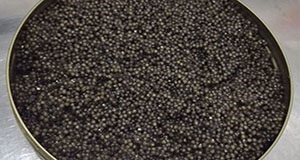Abstract
People all over the world eat fish and shellfish eggs. Seafood roes are among the most valuable of fishery commodities because they are considered a delicacy and sell for a high price. The eggs can be acquired as whole roe, (the eggs still attached to the ovary, as with mullet), or as individual eggs that may be collected directly from where the female deposits or spawns her eggs (for instance, “tobiko,” from flying fish), or by harvesting the female and separating the eggs from the ovary (as with salmon, lumpfish, and sturgeon “caviar”). The most sought-after and high-valued of all seafood roes are the eggs obtained from the sturgeon. Traditionally coveted by royalty and the aristocracy, sturgeon caviar today is prized by chefs and discerning food connoisseurs the world over for its delicate flavor and nutrient-rich health benefits. Learn what caviar is, find out how it’s collected, and discover more about the fascinating sturgeon fish in this 4-page fact sheet written by Frank A. Chapman and Joel P. Van Eenennaam, and published by the School of Forest Resources Program in Fisheries and Aquatic Sciences, June 2016.
FA194/FA194: Technically Speaking, What Is Sturgeon Caviar? (ufl.edu)
References
Batista, I. 2007. "Fish roe." Pages 181-185. In: F. Shahidi, editor. Maximising the values of marine by-products. Boca Raton, Florida: CRC Press LLC.
Bledsoe, G. E., C. D. Bledsoe, and B. Rasco. 2003. "Caviar and fish roe products." Critical Reviews in Food Science and Nutrition 43(3): 317-356. https://doi.org/10.1080/10408690390826545
Bronzi, P., H. Rosenthal, and J. Gessner. 2011. "Global sturgeon aquaculture production: an overview." Journal of Applied Ichthyology 27: 169-175. https://doi.org/10.1111/j.1439-0426.2011.01757.x
Carey, R. A. 2005. The philosopher fish: sturgeon, caviar and the geography of desire. Counterpoint, New York, New York.
Chapman, F. A., and J. P. Van Eenennaam. 2007. Determining the stage of sexual maturity in female sturgeon for artificial spawning. FA153. Gainesville: University of Florida Institute of Food and Agricultural Sciences. http://edis.ifas.ufl.edu/fa153
Gall, K., K. P. Reddy, and J. M. Regenstein. 2000. "Fish roe and caviar." Pages 412-416. In: R. E. Martin, E. P. Carter, G. J. Flick, and L. M. Davis, editors. Marine & Freshwater Products Handbook. Lancaster, Pennsylvania:Technomic Publishing Co.
Jarvis, N. D. 1964. Caviar and other fish roe products. U.S. Fish and Wildlife Service, Fishery Leaflet 567
Memis, D. 2014. "A short history of sturgeon caviar production in Turkey." Journal of Applied Ichthyology 30(6): 1552-1556. https://doi.org/10.1111/jai.12602
Price, R. J. 1979. Fish eggs for caviar and bait. Division of Agricultural Sciences, University of California, Leaflet 21114.
Saffron, I. 2002. Caviar: the strange history and uncertain future of the world's most coveted delicacy. New York, New York: Broadway Books.
Siddique, M. A. M., J. Cosson, M. Psenicka, and O. Linhart. 2014. "A review of the structure of sturgeon egg membranes and of the associated terminology." Journal of Applied Ichthyology 30: 1246-1255. https://doi.org/10.1111/jai.12604
Sternin, V., and I. Doré. 1993. Caviar - The Resource Book. Moscow: Cultura.

